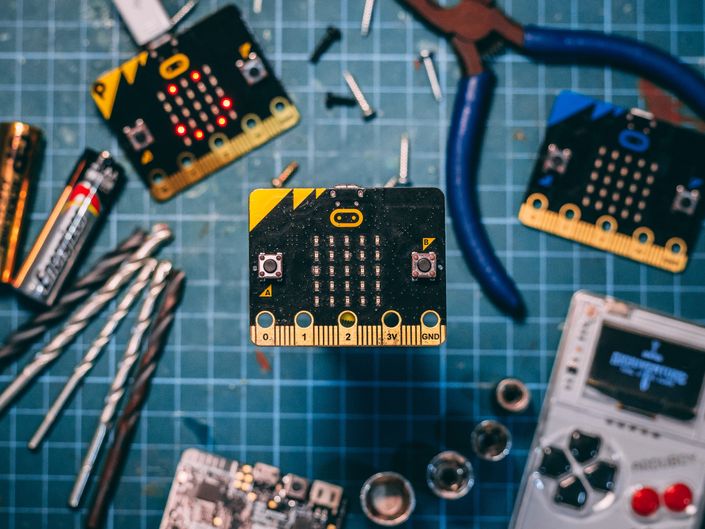
A-Z Robotics: Learn coding & electronics on MicroBit through fun projects
Absolute beginner's guide to learning coding, electronics and robotics on the microbit with many fun projects to turn you into an expert
Watch Promo
Please note that this a free version of the A-Z course. For the full version. Go to https://www.udemy.com/a-z-robotics-project-based-c... USE COUPON 'TINKERSPARK' for a 75% percent discount
____
Have you always wanted to understand the hype behind robotics, coding, electronics, tech, but were overwhelmed by the complexity and not sure where to get started?
This course will avoid all that confusion by taking you step-by-step through understanding everything about robotics, coding and electronics.
Each module of this course revolves around learning key concepts via building fun projects, robots and experiments. Some of the projects we create in the course are: Sunflower robots, Wall detection cap for blind people, air piano, deuce game generator, digital hot-potato, Treasure hunt using wireless data transmission, pressure sensitive instrument, rock paper scissors generator and more!
Furthermore, each module of the course also includes concepts breakdowns, coding walk-through, challenges and assessments, assembly videos, and demos.
The course is centered around the BBC Microbit Platform: The world's easiest and most friendly electronics and coding platform. In fact all the coding can be done on any device- compter, tablet, or phone.
All the code we write will be picture based graphical code. No confusing text based code! Graphical code is much easier to understand but the computer science principles learnt in the course are identical to what professional programmers use.
The course progression is as follows:
- The course will first introduce us to what the MicroBit platform is and how to use it
- Then we will learn the fundamentals of programming and computer science (coding)
- We will then dive in to electronics by exploring the built in sensors and output devices of the MicroBit (simple electronics)
- Only once comfortable with coding and electronics such as sensors will we start to use external electronics and learn how to wire (code+advance electronics + robotics)
- Lastly we learn how to integrate wireless communication into our projects.(code+electronics+robotics)
Each module will build on what you learn't in the previous module and no prior knowledge will be required.
This course will make you a creator, an innovator, a leader in a increasingly digital world filled with robots. With a solid understanding of electronics, sensors, and computer science principles, you will be primed to progress to harder concepts like IOT, AI, Machine learning. Learnings from this course will be applicable to all fields from manufacturing, or military, automation, self-driving cars, smart cities etc.
Tools required-
No hardware & tools needs to be purchased. MicroBit has a free built in online simulator. However, it is recommended that you do purchase the following hardware to physically see how your code works for the projects we create.
Module 1-Module 3- Just a MicroBit
Module 4- LEDs, Push Button, Servo, Distance sensor, speaker/earphones for music, moisture sensor, aligator clips + jumper cables
Module 5- Secondary MicroBit
A full list of recommended hardware + multiple purchase links (with international shipping) is available here: http://bit.ly/parts_TinkerSpark
Your Instructor

Saral Tayal started his journey in the maker movement at the age of 12, is enrolled to study engineering in Carnegie Mellon University.
He runs a robotics education company in Singapore called Tinker Spark
His achievements include being the Grand Prize winner in Amazon’s worldwide voice activated challenge for his Smart Mirror Project. His Maker blog where he publishes his best projects has nearly a quarter million views. He has been published as a featured maker in UK-Based Hack-Space Magazine and has been also featured by Intel, ZaoBao Newspaper, Autodesk, Vulcan Post, Yahoo!, Hackaday, and Instructables. He has also judge robotics on national television (SYAA) and often talks in events such as IOTAsia, Campus Party etc.
Sharing his passion for learning has been an integral part of Saral’s making journey. At the age of 14, Saral joined XPC: one of Singapore’s first Makerspaces sponsored by Home-Fix. Here he helped design the electronics fab lab and mentor and guide fellow builders and students with their projects in the makerspace. Working With XPC, he helped organize Maker’s Block event, one of Singapore’s first Makerspaces. This was the first time he had the opportunity to reach out to a large audience and spread the concept of the maker movement. Here he held an intro to soldering and recycled cardboard f1 car building workshops while giving talks on 3D printing and what it means to be a maker. After his work with XPC, he was invited to intern with Qwikfab: a niche 3D printing startup in Singapore that built custom 3D printers for clients such as NUS, RedHat Linux, and A-Star. Here he was a key member in the design team that built their flagship 3D printer: The Beast 2.0 printer. With QwikFab, he participated in his second maker faire in Singapore where he showcased the advantages of rapid prototyping and 3D printing to a mass audience. Saral also has work and internship experience with AIG on media creation, Imran Repair in repairing consumer electronics such as laptops and cellphones. He has also worked with the Liter of Light initiative in India to install solar street lamps in areas without electricity, he has worked with government agencies on city wide cleaning protocols in India, and helped build a primary school for dunda village in India.

